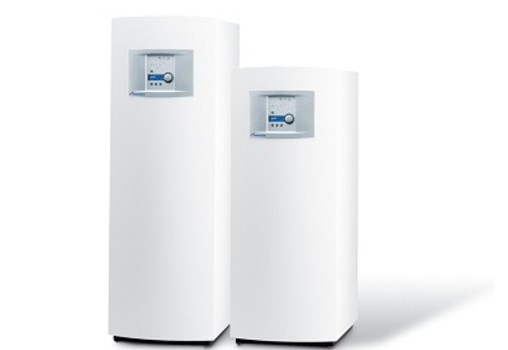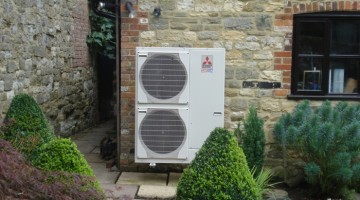
What are ground source heat pumps?
Ground source heat pumps use the earth as a heat source, taking advantage of the stable temperatures in the ground to provide heat and hot water for the home.
Ground source heat pumps are not a new concept and have been around since the 19th century. This technology became very popular in Sweden in the 1970s and since then units have been sold worldwide.
In the UK, there has been a sudden surge in demand in heat pumps since the launch of the Renewable Heat Incentive, which pays homeowners for each unit of hot water produced. Although rates are no longer as high as they were, they can still cover much of the initial install costs of the systems.
How do ground source heat pumps work?
A ground source heat pump system uses heat trapped beneath the ground and boosts it to a higher temperature using a heat pump. This heat is then used to provide home heating or hot water. The heat pump performs the same role as a boiler does in a central heating system, but uses ambient heat from the ground rather than burning fuel to generate heat.
Initially, a heat transfer liquid (normally glycol) is pumped through pipes buried deep in the ground. As the liquid travels through the pipework it absorbs ambient heat from the ground and warms up, before returning back to the ground source heat pump unit. Once it returns, a heat exchanger removes the heat from the liquid and it then continues to travel round and round the pipework in a continuous cycle.
The low-grade heat is transferred through the heat exchanger, then passes through a heat pump compressor which drives the temperature up to a level that is usable for heating and hot water.
How much pipework does a GSHP require?
The length of the ground loop depends on the size of your home and the amount of heat you need – longer loops can draw more heat from the ground, but need more space to be buried in.
The pipework can either be laid horizontally or vertically. If laid horizontally, the pipework tends to be buried in trenches 2-3m deep, spread over a huge surface area to ensure the heat transfer liquid has the opportunity to increase to a sufficient temperature. If the pipework is installed vertically, boreholes get drilled in to ground (at a cost of £6,000 – £8,000 for each borehole!). These need to be drilled by professionals and will regularly exceed 100m in depth to ensure that the heat transfer liquid again has the opportunity to absorb enough heat.
There are two types of ground source heat pump, and both have a few components in common – they consist of a ground heat exchanger, a heat pump and a heat distribution system (e.g. underfloor heating or radiators).
Closed loop ground source heat pump
The majority of ground source heat pumps installed today are closed loop heat pumps. As the name suggests, no outside liquid enters the loop of pipework at any point. In this set up, a sealed loop of high density polyethylene pipe is laid either vertically or horizontally in the ground. The heat transfer fluid is in a completely closed system travelling through the pipework and returning back to heat pump.
Open loop ground source heat pump
The open-loop ground source heat pump uses ground water to pump around the system; however the number of installations of this type are decreasing, mainly because you need a source of groundwater. Also an additional associated issue with the open loop ground source heat pump is that the quality of the groundwater can actually have a detrimental effect on the system.
Ground source heat pumps require electricity
The fact that ground source heat pumps run on electricity suggests that they are expensive to run (electricity is approximately 15p / kWh while gas is just 4p / kWh). However heat pumps are in fact incredibly efficient.
In fact, ground source heat pumps are even more efficient than air source heat pumps, converting each unit of electricity (required to run the pump and compressor) into 3.5 – 4.5 units of useful heat. Compare this to a brand new energy efficient boiler, which converts each unit of gas into just 0.9 units of useful heat.
The efficiency of air source heat pumps is measured by the Coefficient of Performance (CoP), which is simply how many units of useful energy are produced from each unit of electricity consumed to operate the system. With air source heat pumps, the coefficient of performance changes throughout the year. This is because since in the winter months, the unit needs to work harder (and hence uses more electricity) to drive the temperature up to an acceptable temperature.
For ground source heat pumps the coefficient of performance is relatively consistent – this means that even in the middle of winter, when hot water and heating demand are at a maximum, the GSHP should be running equally as efficiently as it does on a red hot summer’s day. This is because the temperature underneath the ground remains relatively constant all year round – and this is one of the key advantages of GSHPs over air source heat pumps.
Heat pumps do have some impact on the environment as they require electricity to run, but the heat they extract from the ground is constantly being renewed naturally, hence they are considered a renewable heating source.
Installing a ground source heat pump
The Energy Saving Trust (EST) recommends households considering a ground source heat pump to consult a Microgeneration Certification Scheme installer and only use a properly accredited professional to complete the work. During its trial, the EST found a variety of heat pumps incorrectly installed, which therefore didn’t perform as efficiently overall as they could have. It is essential to use an MCS-approved installer to qualify for the Renewable Heat Incentive.
It is important to shop around and we always recommend getting several quotes before choosing the best option for you. Studies have shown that most suppliers tend to exaggerate the savings in energy costs this system will produce.
Renewable Heat Incentive
Heat pumps are part of the Government Renewable Heat Incentive (RHI) scheme. It means that you can get paid for every unit of renewable heat you generate. You can get a significant chunk of the cost of installation back over 7 years of payments – not to mention the savings to be made from the heat pump itself. Read more on that here.
Benefits
- Ground source heat pumps can lower fuel bills, especially if you are currently using conventional electric heating (saving of £420), LPG or oil (saving of £50).
- Ground source heat pumps are often classed as a ‘fit and forget’ technology because they need little maintenance, and no fuel deliveries are required, however they provide space heating and hot water 24/7.
- Can reduce your carbon footprint: heat pumps can lower your home’s carbon emissions, depending on which fuel you are replacing.
Limitations
- Ground source heat pumps require a reasonable amount of land outside to lay the coils underground. If this is unavailable the technology will not be suitable for your home.
- If you have a vertically submerged closed loop system and there is a leak, it can be difficult to gain access to.
Cost
- From £13-20,000.
Installing heat pumps
Are you thinking about getting a heat pump? We have scoured the country for the best tradespeople, so that we can make sure we only recommend those we really trust.
If you would like us to find you a local heat pump installer, just fill in the form below and we will be in touch shortly!













My friend had a ground source heat pump installed on her property and the bore holes they drilled caved in in leaving her with an overall cost significantly higher than the starting quote. Does this happen regularly or is it down to cowboy ‘drillers’. Since their heat pump has been installed they have been happy with it, however for us the outlay is very high so I just want to know whether they were unlucky or this is quite a common issue?
Hi Xavier, Normally if boreholes are being drilled as part of the ground source heat pump install, then the drilling company will offer a certain length of collaring e.g. 10m or 20m. This means that if they go through a particularly soft area of earth they can reinforce it with a collar to ensure it doesn’t collapse. The issue of course is that despite looking at the bedrock before drilling it is very difficult to know how much of the drilled borehole will require a reinforcing collar. I would suggest trying to establish / agreeing a cost for the additional collaring prior to getting the ground source heat pump bore holes drilled so if you do need additional collars then you know what the cost will be.
I am interested in getting a ground source heat pump. We are off mains gas and we have a large field out the back of our home which I feel would house the pipework necessary. Does the pipework need to be a certain length to ensure the water warms up a sufficient temperature? i.e every 100m will cause the water to increase by 0.1 centigrade? Does such a formula exist as I get that would be useful to work out hope much pipe we need to lay for the ground source heat pump as I think we could save considerably on the install cost if we do this part ourselves and get the MCS installer to install the actual heat pump.
I would like to install a ground source heat pump in Harrow, North West London. We have a 800ft by 200ft garden, which is fairly large for this part of London. Do you know if there are any planning restrictions that would prevent us installing a ground source heat pump in a fairly urbanised area.?
I have to say I am on abit of a crusade at the moment. I got a ground source heat pump fitted 8 years ago and it cost just over £4,000. It was ok for several years but last winter it broke down and I was told it would cost about £13,000 to replace the unit.
Either I got a great deal or people are getting ripped off for heat pumps these days. I’m going to go with the latter. What do you say to that then GreenAge?
Hi Jim,
We had a very similar call just last week on this one – I think to be honest you got a great deal! Do a simple google search now on the cost of a ground source heat pump and the price of the unit itself (pre install) is £14k inc vat – this is a Dimplex one on the plumb centre website.
I don’t though think people are getting ripped off nowadays – much of the initial outlay comes back to the homeowner in the form of the RHI. The beauty of heat pumps is that they are actually very simple bits of kit. So the heat pump unit itself should just last 25 years plus (far longer than a boiler).
I don’t know how you can charge £14K for ‘a simple bit of kit’? How does that work? If its that simple it should be the same price as a boiler! Can you tell me what the cheapest heat pump unit on the market is?
The RHI is all very good but it doesn’t really help with the cost up front. Not sure where Im going to find 13,000 from at the moment. Good job i don;t need one of those boreholes dug or Id have to take out a second mortgage.
Hi Jim,
thanks again for the comment. The £14k does include everything required for the heat pump to operate including a hot water tank. Vaillant GeoTherm 10Kw Ground Source Heat Pump is £6.5k to buy, but that doesn’t include anything else – it is just the ground source heat pump unit. To be honest, I would go for a well known make since it will likely last longer than simply going for the cheapest model.
In terms of the RHI – indeed it doesn’t help with the up front cost of the heat pump sadly – We have spoken to the Government team responsible for setting up the scheme, it was simply designed to help increase uptake of renewable energy (i.e. make it more attractive). That was the brief from the Labour Government at the time, rather than helping a certain part of society benefit.
I’ve been following your blogs for a long time. My wofe and I would now like to explore changing our heating system to a ground source heat pump with underfloor heating. Can someone explain to me how it all works with the green deal and the renewable heat incentive which you call rhi.
I’ve had a geothermal ground source pump installed to my 2nd home last year. It was working fine up until last week when we simply couldn’t turn off the hot water. Do you know if they are typically on a timer or switch or thermostat? I tried to call the installation company but I think since then they may well have gone into administration. What would you advise?
We have looked the maintenance cost of our oil boiler and the numbers are not beginning to stack-up. Every year it is a massive chore to have it serviced and have various valves cleaned. So I am on the look out for alternatives and I came across this fantastically simple and informative page. I am after a ground source heat pump system that works! Don’t want it too fancy so I am in two minds about Nibe or the Dimplex. Now, the house we live in has a fairly large garden and I am sure we can have a trench in there as well as a borehole. However, having read various forums, I have seen that most people go for the borehole as their solution. Not too worried about the cost as we were looking to have internal refurbishment and installing underfloor heating with the system. Would you recommend anything else before we embark on this journey?